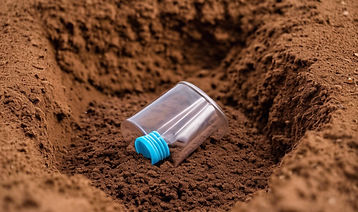
The issue
Microplastics are particles of plastic that are less than 5mm in size caused by either intended manufacturing or the break down of larger plastics. They are unavoidable. They are everywhere. From oceans and rivers to soil, and even the air we breathe. Because they are so small, microplastics have found their way into all aspects of earth, raising concerns about their impact on human, animal, and environmental health. So we're presenting options...
The air
Microplastics are being increasingly found in the air. While this mainly affects urban areas, some studies have found more microplastics in the air in rural areas also.

The water
Up to 83% of tap water worldwide has been found to contain microplastics largely due to plastic waste in the oceans, rivers, and soil. Even the most remote and deepest parts of the ocean are contaminated by microplastics.

The food
Microplastics have been found in virtually all foods from fruit and vegetables to marine organisms and even honey. Since they reside in so many entities, they enter our food through various means such as soil, air, and water

The earth
As plastic degrades, microplastics are embedded in the soil negatively impacting soil health, plant health, and inevitably our health. They can also run into groundwater and rivers from this initial soil contamination.

The clothes
Through nothing more than wash and wear, microplastics are released from many items of clothing. Nylon, polyester, acrylic, and polyamide are some examples of plastic clothing material that can release microplastics.

The cosmetics
Microplastics in cosmetics is different as they are mostly manufactured to be included. While they may be intended to be in the product and used as such, there are many downsides to using cosmetics that include microplastics.

ok, but what effect does this have?
Ecological impact
microplastics produce harmful effects in both aquatic and terrestrial animals. research shows they can cause structural and biochemical damage to organs such as the intestine, liver, gills, and brain, leading to dysfunctions in feeding behavior, fertility, metabolism, and oxidative stress responses. They also affect plant health by blocking pores in seed coating or roots leading to alterations in leaves and roots, impaired hormonal regulation, and decline in chlorophyll and photosynthesis.
Human impact
As with animals and plants, microplastics can cause drastically harmful effects in humans. These effects consist of DNA damage, organ dysfunction, metabolic disorder, immune response, neurotoxicity, as well as reproductive and developmental toxicity. There is also evidence to suggest that a variety of chronic diseases may be related to microplastics exposure.
It is important to note that these are just some of the first studies to research microplastics in people. It is discussed that similar evidence will be produced once a standardised measure of microplastics is in developed.
ok, but why should I care?
With early studies providing evidence for the detrimental effects of microplastics in humans, animals, and the environment, it is clear that this is, and will be, a major issue in the coming years. Additionally, the long-term effects of microplastics are largely unknown, meaning the harmful effects that we do know about might not be the worst of it.
While microplastics are not completely unavoidable, there are actions you can take to decrease your exposure. You have the power to limit the harm this can do to you and the environment.
